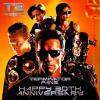|
SCI FI FAN ART GALLERY #03 |
Updated: November 18, 2024




































































































1900 1920s:
Science fiction films appeared early in the silent film era, typically as short films shot in black and white, sometimes with color tinting. They usually had a technological theme and were often intended to be humorous. In 1902, Georges Melies released Le Voyage dans la Lune, generally considered the first science fiction film, and a film that used early trick photography to depict a spacecraft's journey to the Moon. Several early films merged the science fiction and horror genres. Examples of this are Frankenstein ( 1910 ), a film adaptation of Mary Shelley's novel, and Dr. Jekyll and Mr. Hyde ( 1920 ), based on the psychological tale by Robert Louis Stevenson. Taking a more adventurous tack, 20,000 Leagues Under the Sea ( 1916 ) is a film based on Jules Vernes famous novel of a wondrous submarine and its vengeful captain. In the 1920s, European filmmakers tended to use science fiction for prediction and social commentary, as can be seen in German films such as Metropolis ( 1927 ) and Frau im Mond ( 1929 ). Other notable science fiction films of the silent era include The Impossible Voyage ( 1904 ), The Motorist ( 1906 ), The Conquest of the Pole ( 1912 ), Himmelskibet ( 1918; which with its runtime of 97 minutes generally is considered the first feature-length science fiction film in history ), The Cabinet of Dr. Caligari ( 1920 ), The Mechanical Man ( 1921 ), Paris Qui Dort ( 1923 ), Aelita ( 1924 ), Luch Smerti ( 1925 ), and The Lost World ( 1925 ).
1930s 1950s:
In the 1930s, there were several big budget science fiction films, notably Just Imagine ( 1930 ), King Kong ( 1933 ), Things to Come ( 1936 ), and Lost Horizon (1937). Starting in 1936, a number of science fiction comic strips were adapted as serials, notably Flash Gordon and Buck Rogers, both starring Buster Crabbe. These serials, and the comic strips they were based on, were very popular with the general public. Other notable science fiction films of the 1930s include Frankenstein ( 1931 ), Bride of Frankenstein ( 1935 ), Doctor X ( 1932 ), Dr. Jekyll and Mr. Hyde ( 1931 ), F.P.1 ( 1932 ), Island of Lost Souls ( 1932 ), Deluge ( 1933 ), The Invisible Man ( 1933 ), Master of the World ( 1934 ), Mad Love (1935), Trans-Atlantic Tunnel (1935), The Devil-Doll (1936), The Invisible Ray ( 1936 ), The Man Who Changed His Mind ( 1936), The Walking Dead ( 1936 ), Non-Stop New York ( 1937 ), and The Return of Doctor X (1939). The 1940s brought us Before I Hang ( 1940 ), Black Friday ( 1940 ), Dr. Cyclops (1940), The Devil Commands ( 1941 ), Dr. Jekyll and Mr. Hyde (1941), Man Made Monster ( 1941 ), It Happened Tomorrow ( 1944 ), It Happens Every Spring ( 1949 ), and The Perfect Woman ( 1949 ). The release of Destination Moon ( 1950 ) and Rocketship X-M ( 1950 ) brought us to what many people consider "the golden age of the science fiction film".
In the 1950s, public interest in space travel and new technologies was great. While many 1950s science fiction films were low-budget B movies, there were several successful films with larger budgets and impressive special effects. These include The Day the Earth Stood Still ( 1951 ), The Thing from Another World ( 1951 ), When Worlds Collide ( 1951 ), The War of the Worlds ( 1953 ), 20,000 Leagues Under the Sea (1954), This Island Earth (1955), Forbidden Planet (1956), Invasion of the Body Snatchers ( 1956 ), The Curse of Frankenstein ( 1957 ), Journey to the Center of the Earth ( 1959 ) and On the Beach ( 1959 ). There is often a close connection between films in the science fiction genre and the so-called "monster movie". Examples of this are Them! ( 1954 ), The Beast from 20,000 Fathoms ( 1953 ) and The Blob ( 1958 ). During the 1950s, Ray Harryhausen, protege of master King Kong animator Willis O'Brien, used stop-motion animation to create special effects for the following notable science fiction films: It Came from Beneath the Sea ( 1955 ), Earth vs. the Flying Saucers ( 1956 ) and 20 Million Miles to Earth ( 1957 ).
The most successful monster movies were kaiju films released by Japanese film studio Toho. The 1954 film Godzilla, with the title monster attacking Tokyo, gained immense popularity, spawned multiple sequels, led to other kaiju films like Rodan, and created one
of the most recognizable monsters in cinema history. Japanese science fiction films, particularly the tokusatsu and kaiju genres, were known for their extensive use of special effects, and gained worldwide popularity in the 1950s. Kaiju and tokusatsu films, notably Warning from Space ( 1956 ), sparked Stanley Kubrick's interest in science fiction films and influenced 2001: A Space Odyssey ( 1968 ). According to his biographer John Baxter, despite their "clumsy model sequences, the films were often well-photographed in colour ... and their dismal dialogue was delivered in well-designed and well-lit sets."
1960s:
With the Space Race between the USSR and the USA going on, documentaries and illustrations of actual events, pioneers and technology were plenty. Any movie featuring realistic space travel was at risk of being obsolete at its time of release, rather fossil than fiction. There were relatively few science fiction films in the 1960s, but some of the films transformed science fiction cinema. Stanley Kubrick's 2001: A Space Odyssey ( 1968 ) brought new realism to the genre, with its groundbreaking visual effects and realistic portrayal of space travel and influenced the genre with its epic story and transcendent philosophical scope. Other 1960s films included Planet of the Vampires ( 1965 ) by Italian filmmaker Mario Bava, that is regarded as one of the best movies of the period, Planet of the Apes (1968) and Fahrenheit 451 ( 1966 ), which provided social commentary, and the campy Barbarella ( 1968 ), which explored the comical side of earlier science fiction. Jean-Luc Godard's French "new wave" film Alphaville ( 1965 ) posited a futuristic Paris commanded by an artificial intelligence which has outlawed all emotion.
1970s 1980s:
The era of manned trips to the Moon in 1969 and the 1970s saw a resurgence of interest in the science fiction film. Andrei Tarkovsky's Solaris ( 1972 ) and Stalker ( 1979 ) are two widely acclaimed examples of the renewed interest of film auteurs in science fiction. Science fiction films from the early 1970s explored the theme of paranoia, in which humanity is depicted as under threat from sociological, ecological or technological adversaries of its own creation, such as George Lucas's directional debut THX 1138 ( 1971 ), The Andromeda Strain ( 1971 ), Silent Running ( 1972 ), Soylent Green ( 1973 ), Westworld ( 1973 ) and its sequel Futureworld ( 1976 ), and Logan's Run ( 1976 ). The science fiction comedies of the 1970s included Woody Allen's Sleeper ( 1973 ), and John Carpenter's Dark Star ( 1974 ).
Star Wars ( 1977 ) and Close Encounters of the Third Kind ( 1977 ) were box-office hits that brought about a huge increase in science fiction films. In 1979, Star Trek: The Motion Picture brought the television series to the big screen for the first time. It was also in this period that the Walt Disney Company released many science fiction films for family audiences such as The Black Hole, Flight of the Navigator, and Honey, I Shrunk the Kids. The sequels to Star Wars, The Empire Strikes Back ( 1980 ) and Return of the
Jedi ( 1983 ), also saw worldwide box office success. Ridley Scott's films, such as Alien ( 1979 ) and Blade Runner ( 1982 ), along with James Cameron's The Terminator ( 1984 ), presented the future as dark, dirty and chaotic, and depicted aliens and androids as hostile and dangerous. In contrast, Steven Spielberg's E.T. the Extra-Terrestrial ( 1982 ), one of the most successful films of the 1980s, presented aliens as benign and friendly, a theme already present in Spielberg's own Close Encounters of the Third Kind.
The big budget adaptations of Frank Herbert's Dune and Alex Raymond's Flash Gordon, as well as Peter Hyams's sequel to 2001, 2010: The Year We Make Contact ( based on 2001 author Arthur C. Clarke's novel 2010: Odyssey Two ), were box office failures that dissuaded producers from investing in science fiction literary properties. Disney's Tron ( 1982 ) turned out to be a moderate success. The strongest contributors to the genre during the second half of the 1980s were James Cameron and Paul Verhoeven with The Terminator
and RoboCop entries. Robert Zemeckis' film Back to the Future ( 1985 ) and its sequels were critically praised and became box office successes, not to mention international phenomena. James Cameron's sequel to Alien, Aliens ( 1986 ), was very different from the original film, falling more into the action / science fiction genre, it was both a critical and commercial success and Sigourney Weaver was nominated for Best Actress in a Leading Role at the Academy Awards. The Japanese anime film Akira ( 1988 ) also had a big influence outside Japan when released.
1990s 2000s:
In the 1990s, the emergence of the World Wide Web and the cyberpunk genre spawned several movies on the theme of the computer-human interface, such as Terminator 2: Judgment Day ( 1991 ), Total Recall ( 1990 ), The Lawnmower Man ( 1992 ), and The Matrix ( 1999 ). Other themes included disaster films (e.g., Armageddon and Deep Impact, both 1998), alien invasion (e.g., Independence Day ( 1996 ) and genetic experimentation (e.g., Jurassic Park ( 1993 ) and Gattaca ( 1997 ). Also, the Star Wars prequel trilogy began with the release of Star Wars: Episode I The Phantom Menace, which eventually grossed over one billion dollars.
As the decade progressed, computers played an increasingly important role in both the addition of special effects ( thanks to Terminator 2: Judgment Day and Jurassic Park ) and the production of films. As software developed in sophistication it was used to produce more complicated effects. It also enabled filmmakers to enhance the visual quality of animation, resulting in films such as Ghost in the Shell ( 1995 ) from Japan, and The Iron Giant ( 1999 ) from the United States.
During the first decade of the 2000s, superhero films abounded, as did earthbound science fiction such as the Matrix trilogy. In 2005, the Star Wars saga was completed ( although it was later continued, but at the time it was not intended to be ) with the
darkly themed Star Wars: Episode III â€" Revenge of the Sith. Science-fiction also returned as a tool for political commentary in
films such as A.I. Artificial Intelligence, Minority Report, Sunshine, District 9, Children of Men, Serenity, Sleep Dealer, and Pandorum. The 2000s also saw the release of Transformers ( 2007 ) and Transformers: Revenge of the Fallen ( 2009 ), both of which resulted in worldwide box office success. In 2009, James Cameron's Avatar garnered worldwide box office success, and would later become the highest-grossing movie of all time. This movie was also an example of political commentary. It depicted humans destroying the environment on another planet by mining for a special metal called unobtainium. That same year, Terminator Salvation was released and garnered only moderate success.
2010s:
The 2010s has seen new entries in several classic science fiction franchises, including Predators ( 2010 ), Tron: Legacy ( 2010 ), a resurgence of the Star Wars series, and entries into the Planet of the Apes and Godzilla franchises. Several more cross-genre films have also been produced, including comedies such as Hot Tub Time Machine ( 2010 ), Seeking a Friend for the End of the World ( 2012 ), Safety Not Guaranteed ( 2013 ), and Pixels ( 2015 ); romance films such as Her ( 2013 ), Monsters ( 2010 ), and Ex Machina ( 2015 ); heist films including Inception ( 2010 ) and; action films including Real Steel ( 2011 ), Total Recall ( 2012 ), Edge of Tomorrow ( 2014 ), Pacific Rim ( 2013 ), Chappie ( 2015 ), Tomorrowland ( 2015 ), and Ghost in the Shell ( 2017 ). The superhero
film boom has also continued, into films such as Iron Man 2 ( 2010 ) and 3 ( 2013 ), several entries into the X-Men film series, and The Avengers ( 2012 ), which became the fourth-highest-grossing film of all time. New franchises such as Deadpool and Guardians of the Galaxy have also begun in this decade.
Further into the decade, more realistic science fiction epic films have also become prevalent, including Battleship ( 2012 ), Gravity ( 2013 ), Elysium ( 2013 ), Interstellar ( 2014 ), Mad Max: Fury Road ( 2015 ), The Martian ( 2015 ), Arrival ( 2016 ), Passengers ( 2016 ), and Blade Runner 2049 ( 2017 ). Many of these films have gained widespread accolades, including several Academy Award wins and nominations. These films have addressed recent matters of scientific interest, including space travel, climate change, and artificial intelligence.
Alongside these original films, many adaptations have been produced, especially within the young adult dystopian fiction subgenre, popular in the early part of the decade. These include the Hunger Games film series, based on the trilogy of novels by Suzanne Collins, The Divergent Series based on Veronica Roth's Divergent trilogy, and the Maze Runner series, based on James Dashner's The Maze Runner novels. Several adult adaptations have also been produced, including The Martian ( 2015 ), based on Andy Weir's 2011 novel, Cloud Atlas ( 2012 ), based on David Mitchell's 2004 novel, World War Z, based on Max Brooks' 2006 novel, and Ready Player
One ( 2018 ), based on Ernest Cline's 2011 novel.
Independent productions have also increased in the 2010s, with the rise of digital filmmaking making it easier for filmmakers to produce movies on a smaller budget. These films include Attack the Block ( 2011 ), Source Code ( 2011 ), Looper ( 2012 ), Upstream Color ( 2013 ), Ex Machina ( 2015 ), and Valerian and the City of a Thousand Planets ( 2017 ). In 2016, Ex Machina won the Academy Award for Visual Effects in a surprising upset over the much higher-budget Star Wars: The Force Awakens ( 2015 ).
|
 HOME
HOME
 About
About
 EMail Me
EMail Me TOP |
TOP |  PREVIOUS ITEM | NEXT ITEM
PREVIOUS ITEM | NEXT ITEM  ( 7 of 14 )
( 7 of 14 )




































































































